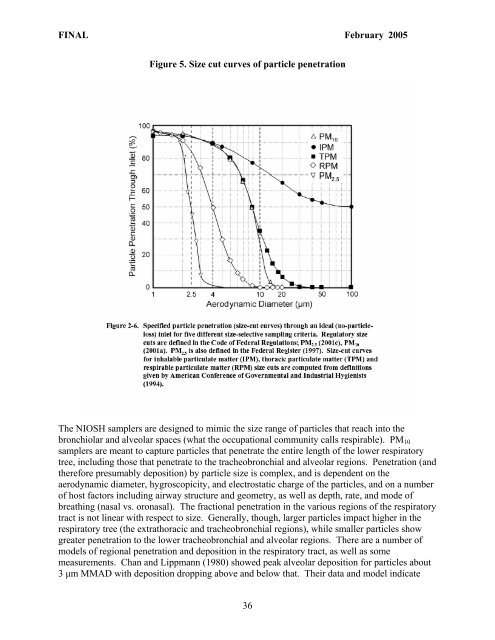Silica (crystalline, respirable) - OEHHA
Silica (crystalline, respirable) - OEHHA
Silica (crystalline, respirable) - OEHHA
Create successful ePaper yourself
Turn your PDF publications into a flip-book with our unique Google optimized e-Paper software.
FINAL February 2005<br />
Figure 5. Size cut curves of particle penetration<br />
The NIOSH samplers are designed to mimic the size range of particles that reach into the<br />
bronchiolar and alveolar spaces (what the occupational community calls <strong>respirable</strong>). PM10<br />
samplers are meant to capture particles that penetrate the entire length of the lower respiratory<br />
tree, including those that penetrate to the tracheobronchial and alveolar regions. Penetration (and<br />
therefore presumably deposition) by particle size is complex, and is dependent on the<br />
aerodynamic diameter, hygroscopicity, and electrostatic charge of the particles, and on a number<br />
of host factors including airway structure and geometry, as well as depth, rate, and mode of<br />
breathing (nasal vs. oronasal). The fractional penetration in the various regions of the respiratory<br />
tract is not linear with respect to size. Generally, though, larger particles impact higher in the<br />
respiratory tree (the extrathoracic and tracheobronchial regions), while smaller particles show<br />
greater penetration to the lower tracheobronchial and alveolar regions. There are a number of<br />
models of regional penetration and deposition in the respiratory tract, as well as some<br />
measurements. Chan and Lippmann (1980) showed peak alveolar deposition for particles about<br />
3 µm MMAD with deposition dropping above and below that. Their data and model indicate<br />
36















